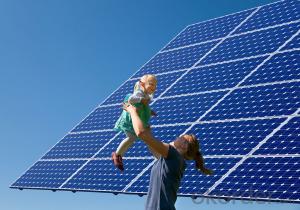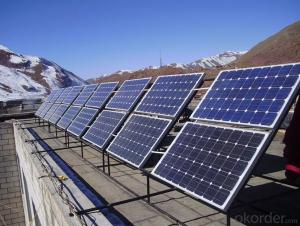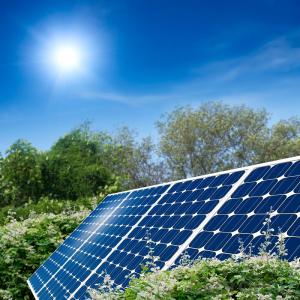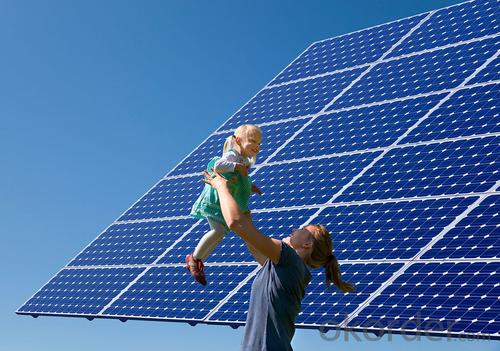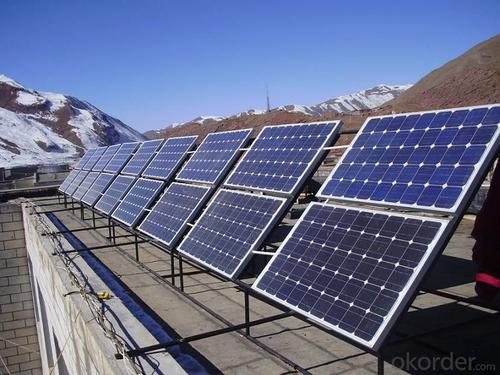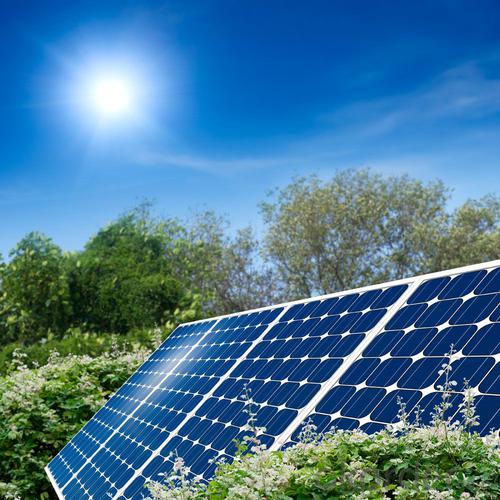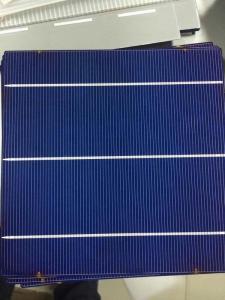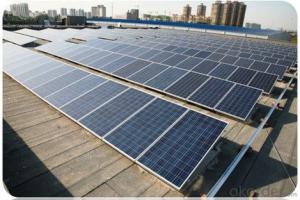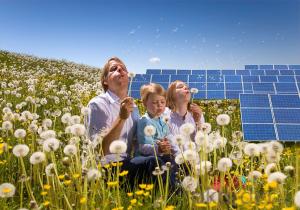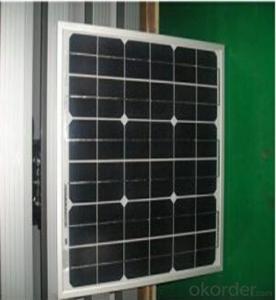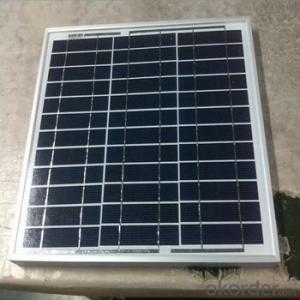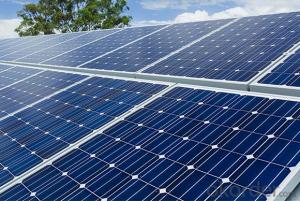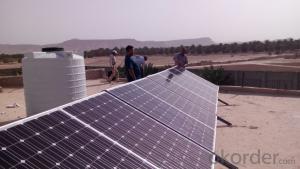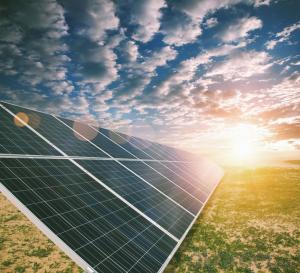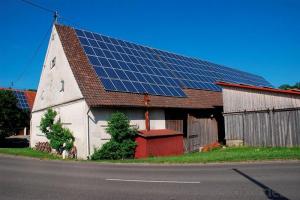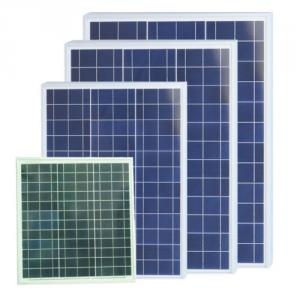Tesla Solar Panels - CNBM Solar Monocrystalline 6 Series (20W)
- Loading Port:
- China main port
- Payment Terms:
- TT OR LC
- Min Order Qty:
- 100000 watt
- Supply Capability:
- 10000000 watt/month
OKorder Service Pledge
OKorder Financial Service
You Might Also Like
Mono-crystalline Solar Module Description:
Mono-crystalline solar module is the core part of solar power systems, as well as the most important part of the solar system. Mono-crystalline solar module consists of high efficiency crystalline silicon solar cell, super white cloth grain toughened glass, EVA, transparent TPT backboard and the composition of aluminum alloy frame. The function of Mono-crystalline solar module is to convert solar energy into electric energy, or sent to the storage battery, or promote work load. The quality of the solar energy battery components and cost will directly decide the quality and cost of the whole system.
Work Principle
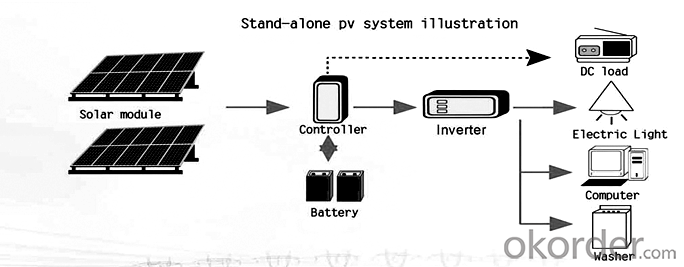
Data sheet
| Characteristics | |
| Max Power Voltage Vmp (V) | 17.2V |
| Max Power Current Imp (A) | 1.17A |
| Open Circuit Voltage Voc (V) | 22.2V |
| Short Circuit Current Isc (A) | 1.24A |
| Max Power Pm (W) | 20W |
| Temperature Coefficient of Cells | |
| NOCT | 47℃±2℃ |
| Temperature Coefficients of Isc (%/℃) | 0.06% |
| Temperature Coefficients of Voc (%/℃) | -0.32% |
| Temperature Coefficients of Pmp (%/℃) | -0.45% |
| Mechanical Data | |
| Type of Cells (mm) | Mono156×22.3 |
| Dimension | 490×350×25mm |
| Weight | 2kg |
| NO.of Cells and Connections | 2×8=16 |
| Limits | |
| Operating Temperature | –45°C to +80°C |
| Storage Temperature | –45°C to +80°C |
| Max System Voltage | 700V |
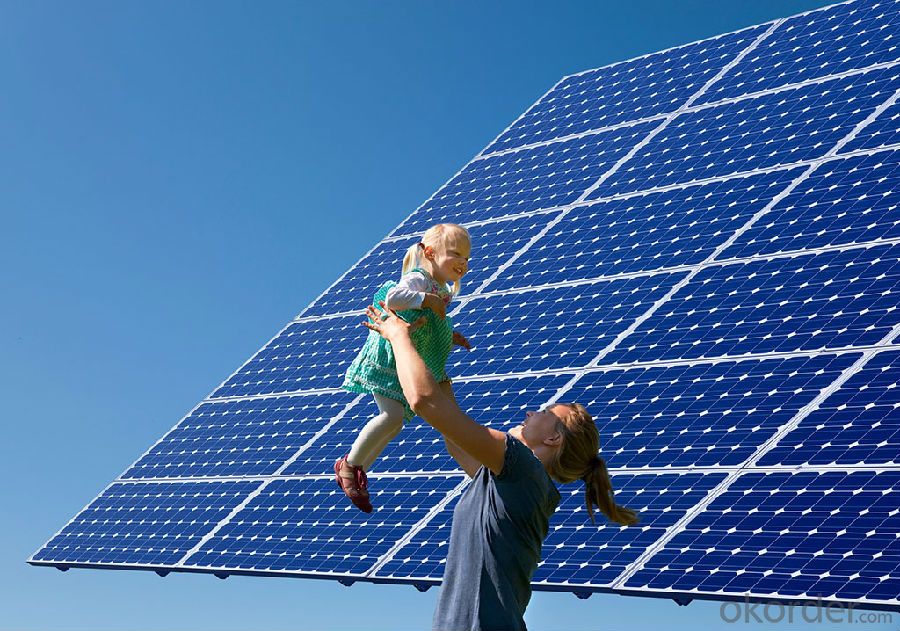
FAQ:
1. How long will my inquiry get response?
Your inquiry related to our products or prices will be replied within 24 hours.
2. Can I get professional service and suggestion?
Well-trained and experienced staffs to answer all your questions in fluent English.
3. Do you accept OEM or customized design?
OEM & ODM, any your customized lightings we can help you to design and put into product.
4. What if I need specific design?
Distributorship are offered for your unique design and some our current models.
- Q: Well I was thinking about the idea of renovating either a smaller school bus or building a tiny house and I was wondering if i can get some information on the size and watts panel should I use or more like how to get that whole solar energy in motion. Any infor and links would help
- I think that typical solar panels are 2'x4' and produce something like 800-000 wh per day. (That's 0.8 - kwh per day.) More in the summer, less in the winter, if they're aimed sort of at the sun. There are newer, more expensive panels that produce more. There are also thin film panels that are less expensive, and probably more sturdy. You then have a couple choices. In a house, you'd have an expensive inverter to connect to the utility power, so you can have power at night when your panels aren't generating anything. In a trailer, you want 2-4-6 deep cycle car batteries to store the power. Then you could have an inverter to convert that power to 20v AC, so you could use normal appliances. Or, you could buy appliances that run on 2 volts DC. Maybe a combination of both. You'll need to figure out how much power you're going to use, so you know how many panels and batteries you're going to need. The calculation is easy. Figuring out how much power you need is hard. You need deep cycle batteries because you can repeatedly charge them way up and run them way down. Ordinary batteries die fairly quickly when you do that.
- Q: How can solar panels be integrated into building designs?
- Solar panels can be integrated into building designs in various ways, such as through rooftop installations, building-integrated photovoltaics (BIPV), solar facades, and solar windows. By incorporating solar panels into the design, buildings can generate renewable energy while minimizing the visual impact and maximizing energy efficiency.
- Q: Can solar panels be used in areas with high levels of electromagnetic radiation?
- Yes, solar panels can be used in areas with high levels of electromagnetic radiation. While electromagnetic radiation can potentially interfere with the functioning of electronic devices, solar panels are designed to withstand various environmental conditions. They are typically equipped with protective measures, such as grounding and shielding, to minimize the impact of electromagnetic radiation. Therefore, as long as the solar panels are installed correctly and maintained properly, they can continue to generate electricity efficiently even in areas with high levels of electromagnetic radiation.
- Q: A homeowner is considering putting a horizontal solar panel on her roof to heat water for domestic use. An average increase of water temperature each day from 60oF to 20oF is wanted for 50 gallons. How large a panel would be needed on a clear winter day at 40o latitude if the overall efficiency is 50%?
- Here's a typical 4' x 8' collector rating. 40 degree latitude would be a cool climate, so you look at row D, water heating in a cool climate. Probably take the middle rating, mildly sunny day, and it is 0,000BTU per panel per day (it's 9,000 on a sunny day). 38,700 BTU / 0,000 BTU = 3.87, they'd need about 3 to 4 panels. If you used the sunny day number, you'd only need 2, but 3 is more realistic, as it is not always a sunny day.
- Q: Can solar panels be installed in areas with high wind speeds?
- Yes, solar panels can be installed in areas with high wind speeds. However, it is important to ensure that the solar panels are designed and installed to withstand the specific wind conditions of the area. This may involve using appropriate mounting systems and anchoring techniques to secure the panels effectively. Additionally, regular maintenance and inspections should be conducted to ensure the panels remain secure and efficient in such conditions.
- Q: I need a solar panel which can light up 4 full loaded 5 rooms appartment houses
- good idea going solar, i would suggest doing a google search, as their are many suppliers. then you need to calculate the amount of wattage you think these apartment houses are going to require. volts x amps = watts. if you are going to be off of the power grid, then you will need a way to store excess energy during good times,( lots of sun) in order to use it during bad times ( no sun ). or see if you are able to sell your extra power back to your local power company, check because some companies do not allow this. you could even have a generator for emergencies if you go off the power grid. on final note, solar is a pretty sizable investment up front and your profits are seen mainly in the long run, but you will get energy savings immediately, but more likely those savings will go to paying off the solar panels also, you will need a converter to convert the ac (alternate current) produced by the panels into dc ( direct current ) which is used by the apartments. it will tie in to the existing electrical system in the apartments. i know germany is really pushing solar energy and they offer their citizens some pretty sweet deals to go solar. the companies are profiting from this so i would suggest looking for a supplier in germany, first. they may have better deals, or try bp (british petroeum) they have been in the solar business for awhile. i wish you success!
- Q: My family moved into a house that came with solar power panels but they are not connected and don't really understand how to even begin.
- You will need help with this. Panels may or may not be 24 volt. If you can find a name tag, you can find out from the manufacturer's web site. Some folks hook them all in parallel. Mine are in series, to create 480 volts. the reason for going to higher voltage is to reduce power loss in the wiring. Even then, I used a wire size larger than recommended. The frames want to be interconnected, and wired to ground. The live conductors connect through disconnect switches to an inverter. The inverter is sized to the output of the panels. Where the utility allows net metering, the inverters are connected through a disconnect switch to the grid, which of course also feeds the house. Assuming you are on the grid, you will not need batteries. If outages severely impact you, you can have batteries. Counting against them is that they are costly, and use part of the power you generate, just to keep them charged. If you have batteries, it is usually best to rewire circuits so noncritical circuits are disconnected during outages. Leaving perhaps minimal lighting, fridge, freezer and critical medical circuits. Learn all you can from the Internet (try solar panels), and from the green search box above. Be sure to see if your state has a rebate program, and the conditions which it requires.
- Q: Are solar panels affected by shade?
- Yes, solar panels are affected by shade. When a solar panel is partially shaded, it can experience a decrease in efficiency and generate less electricity. Shade can create "hot spots" on the panel, leading to the overall reduction in power output. Therefore, it is important to install solar panels in areas with minimal shade to maximize their energy production.
- Q: What makes them stop working after a while?
- They are used in an environment that's very harsh for semiconductors, especially the high temperatures. Ion migration and many other failure mechanisms increase with temperature. Thermal expansion adds its own mechanical stresses.
- Q: Can solar panels work at night?
- No, solar panels cannot work at night as they rely on sunlight to generate electricity.
Send your message to us
Tesla Solar Panels - CNBM Solar Monocrystalline 6 Series (20W)
- Loading Port:
- China main port
- Payment Terms:
- TT OR LC
- Min Order Qty:
- 100000 watt
- Supply Capability:
- 10000000 watt/month
OKorder Service Pledge
OKorder Financial Service
Similar products
Hot products
Hot Searches
Related keywords
